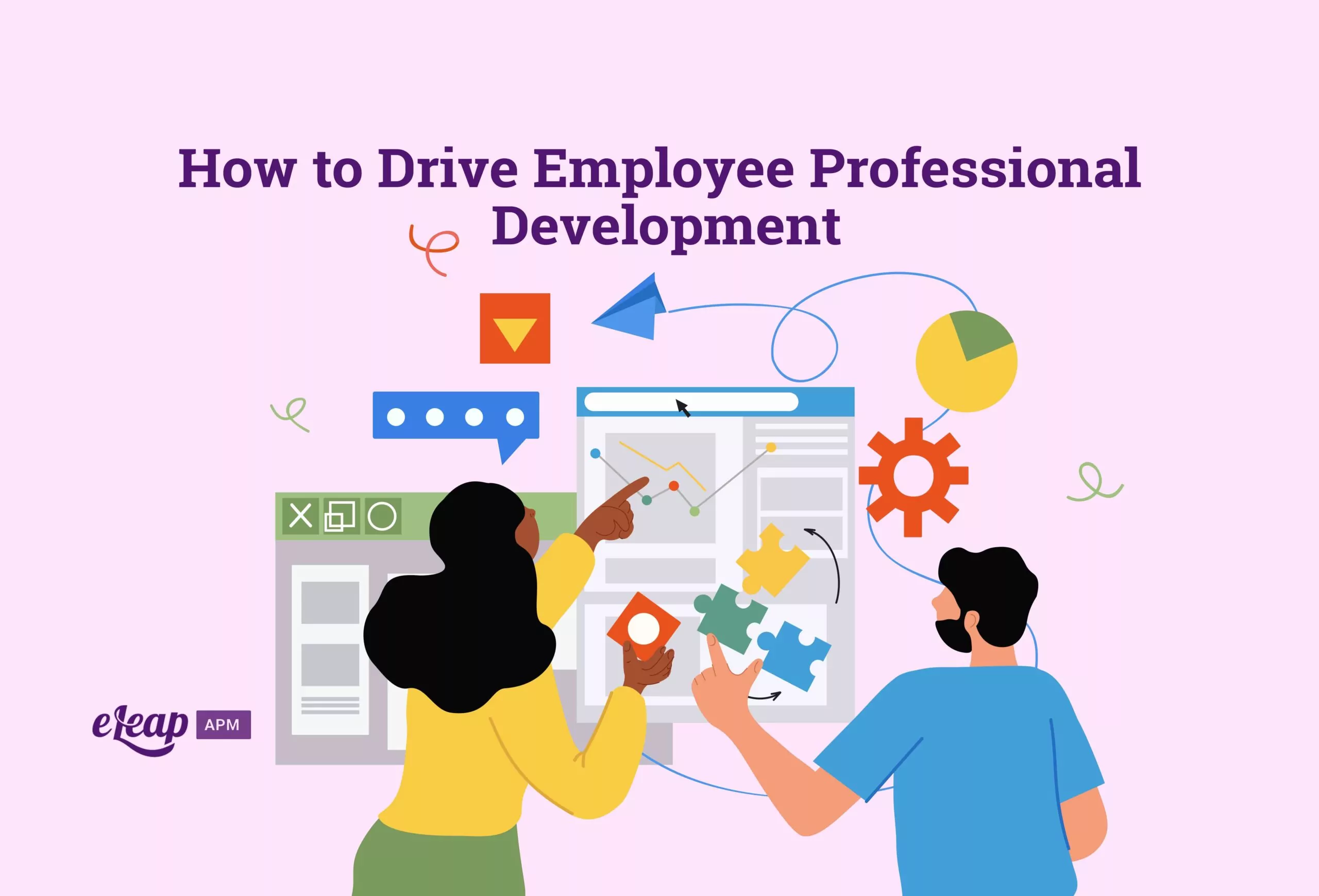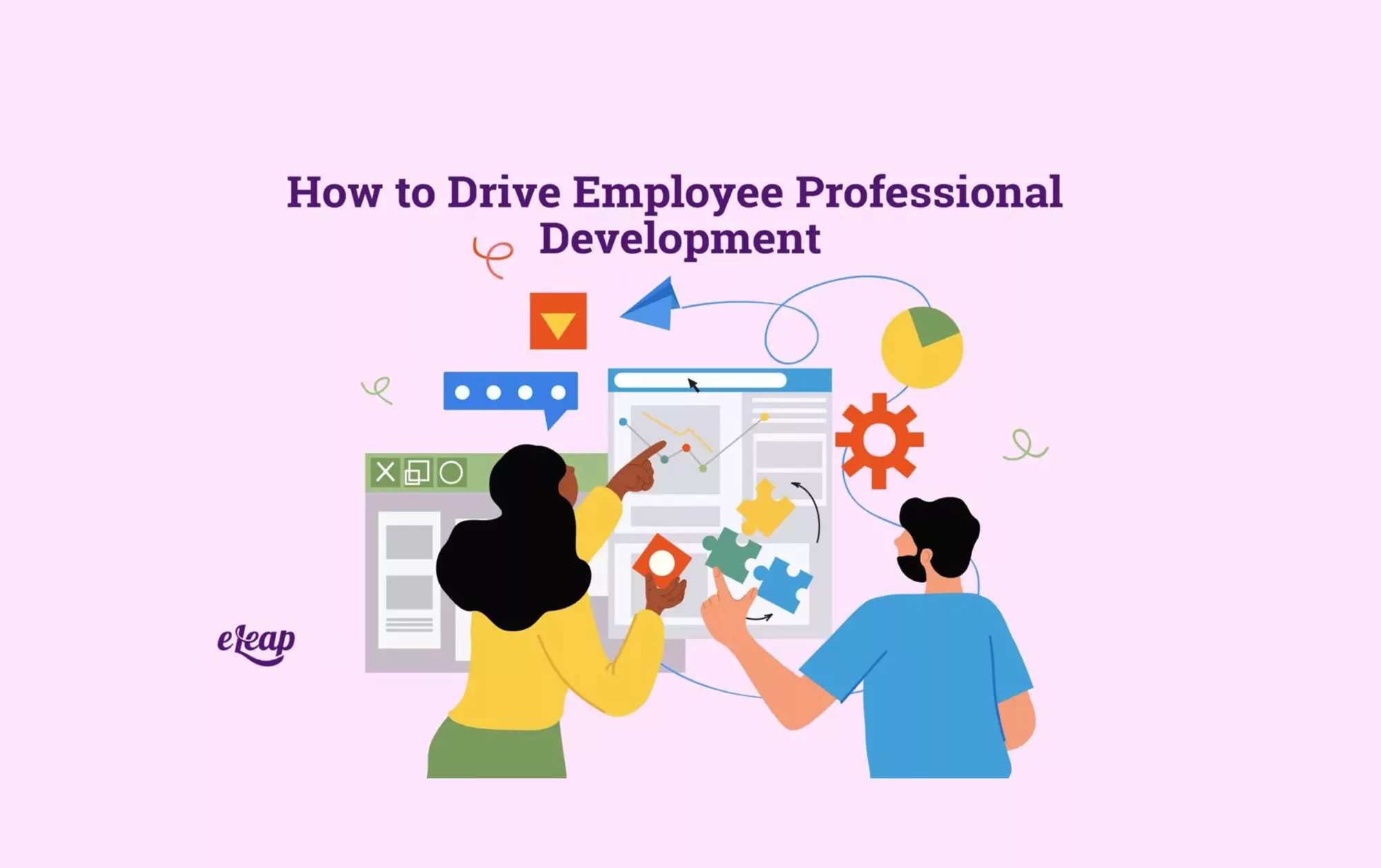How to Drive Employee Professional Development

Providing ample resources for employee professional development opportunities is one of the best ways to retain valued employees. Employees need the potential for upward mobility to feel motivated in their roles. Tools for professional development must be offered for employees to achieve their goals. Explore how eLeaP®’s Performance Management Platform can simplify evaluations, boost productivity, and drive measurable results.
Research shows employees who feel they are advancing in their careers are 20% more likely to still be at their company in one year. More than 70% of high-retention-risk employees say they will be forced to leave their current company to advance their careers.
To keep employees around, companies must focus on providing career development. Having professional growth paths laid out for them is important in making employees feel seen in their companies.
There are several benefits to investing in employee professional development. Providing career advancement opportunities is the responsibility of the company and the manager. It’s also the employee’s responsibility to take the correct steps to reach certain goals.

What is Employee Professional Development?
Employee development is the process of identifying an employee’s current skillset and building on it. By identifying employees’ strengths and deficiencies, employers can set each employee on a unique career path.
Employee development programs let employees improve and build their skillset, allowing them to complete more complex work. The end goal is for employees to reach a point where they outgrow their current roles and can take on higher roles in the company.
By developing employees, companies benefit from lower turnover and swifter filling of open roles internally. Organizations can mold their employee’s development to match the skills needed to excel in senior roles in their company. Organizations keep employees longer and spend less on recruiting efforts with proper employee development.
How to Support Employee Professional Development
Supporting employee growth only helps an organization. However, many organizations do not prioritize employee development. In some situations, the immediate needs of the organization take priority, and employee development efforts suffer.
It doesn’t have to be this way. Organizations can create structures to ensure employee professional development is consistent. Developing and implementing an employee development program is crucial to your company’s success.
There are many factors an organization should implement to support employee development.
Offer Consistent Training from The First Day
Employee development should start on the first day at the company. Onboarding should include informational and mandatory training sessions. Without this, many employees may perform poorly in their roles. However, if they had been given the proper training, they likely would have done great.
Comprehensive training during the onboarding process helps new employees acclimate and facilitates their success in their new roles. However, training and development shouldn’t stop when an employee gets tenured.
Ongoing development opportunities should be offered to employees at every level. Employees improve when they are given the resources to do so. Although “learning by doing” can be effective, development courses provide structured time for employees to focus on learning.
Offering ongoing development opportunities shows employees you care about their growth and builds a more knowledgeable team altogether.
Create Individual Development Plans for Employees
Although group training courses are great for building skills, 1-on-1 development programs benefit employees in other ways.
An individual development plan (or IDP) is a roadmap created between a manager and an employee. The IDP takes the employee’s goals, such as what role they want to be promoted to, and maps out actionable steps to get there.
Individual development has uses outside of mapping out promotions, though. Creating an IDP can help an employee who has struggled with certain skills improve their skillset. An IDP catalogs the current strengths and weaknesses of each employee. From there, managers can help map out steps to improve on those areas of opportunity.
Every employee has career aspirations, but many employees don’t know how to reach them. This can lead to high turnover.
Also, employees might know they have areas for improvement but don’t know how to improve on them. Telling an employee they need improvement in a certain skill is useless if the manager doesn’t provide tools to help them improve.
The IDP allows managers and employees to have a candid conversation and make a game plan. Employees appreciate feeling valued, and managers will appreciate the ease in which an IDP can be followed by employees.
Provide Consistent Feedback
Consistent and helpful feedback is an important piece of effective employee development.
Some managers shy away from feedback and fear it being perceived as criticism. Other managers offer feedback regularly but might do it in a way that is perceived as criticism. Both managers are not providing effective feedback to their employees.
If your managers shy away from feedback, it’s beneficial to offer training that shows them how to give constructive feedback. If your managers receive complaints from their team about their feedback, it’ll benefit them to provide training on tone and word choice when giving feedback.
When a manager can deliver feedback correctly, it helps employees. Employees need to know what they are doing well and what they could be doing better to improve. Constructive feedback helps employees improve continuously.
Prioritize Communication
The success of every efficient organization comes down to how well they can communicate.
This is true regarding the success of employee development as well. It’s estimated that about 70% of learning happens on the job. This means employees must be able to communicate effectively with their peers to maximize peer-to-peer learning.
Employees should be encouraged to share knowledge and offer knowledge freely to team members. Overly competitive work environments will inhibit peer-to-peer learning. It’s important to create a culture where employees feel everyone is a unified team.
Setting unified group goals within a team can help facilitate this. In addition, cultivating a culture of support and learning is critical in any organization.
Prioritize Wellbeing
People perform better at work when they feel better generally. For this reason, development should be looked at in a holistic sense.
If someone has overarching issues in their personal lives, that will bleed into their work. That’s why it is important for companies to offer mental health services, addiction programs, grief counseling, and similar benefits.
By making a point of getting to know your employees on a personal level, you can understand what outside circumstances might be affecting their performance. Successful employee development looks at the employee as a whole – not just who they are at work.
Make Resources Visible and Accessible
Your development resources aren’t useful if they are difficult to locate. For this reason, organizations should make it a point to outline where to find them.
Some ways to make your development resources easily accessible to employees are:
- During onboarding, show employees where to find internal development resources. Encourage them to revisit as time goes on.
- If your company offers reimbursement for outside training and education, be sure to make it clear. Post it somewhere visible and show employees where to find information on reimbursement limits.
- Send a monthly newsletter to the company about upcoming and nearby development opportunities. Reminding employees of these opportunities is key. Sometimes, development gets put on the back burner for more immediate tasks.
Host Lunch and Learn Sessions
We’ve already highlighted how important peer-to-peer learning is in the workplace. Lunch and learn sessions facilitate peer-to-peer learning in a structured way.
Starting a lunch and learn program in your organization is simple. First, send out an inquiry to see how many employees would be willing to create a lunch and learn presentation. In these sessions, one employee presents to the company about their job role and day-to-day tasks.
Then, schedule the employees that volunteered to present on certain days. Typically, lunch and learn sessions happen weekly or monthly. Then, arrange for a catered meal. “Lunch” is an important piece here!
After that, send out a company-wide meeting invite for your first lunch and learn session. Briefly explain what a lunch and learn session is. In short, a lunch and learn session is a way for employees to learn about other job roles, often in different departments than their own.
Lunch and learn sessions help facilitate development because they provide employees with the bigger picture. Someone in sales might think what they do does not affect product development daily. A lunch and learn session may show them how interconnected the two are.
Lunch and learn sessions are helpful when it comes to employee professional development. Employees may hear a presentation and get interested in the role. It can help employees decide what career path they want to take within the company.
Plus…, a free lunch is sure to draw a decent crowd!
Bottom Line
Employee professional development is extremely vital to the overall health of the business. If employees feel they cannot grow, they will look elsewhere. At the very least, employee development is a way to inhibit turnover.
More importantly, employee development is rewarding for both employees and managers. By encouraging employees to develop, a company secures qualified internal candidates for their next job opening. Since development is such a crucial piece of career fulfillment, organizations must have a robust employee development plan in place.